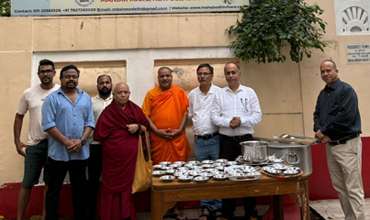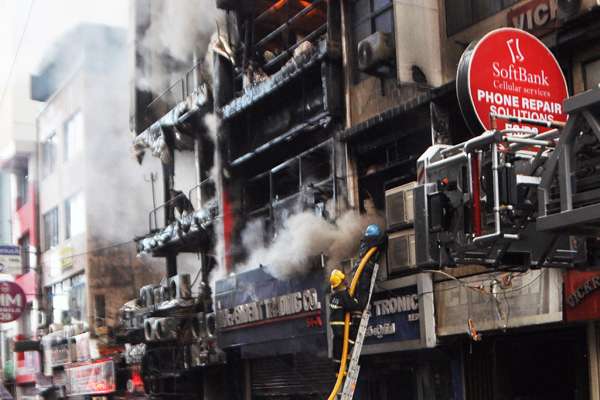Colomboscope 2019 : Building the Breakwater
The sixth edition of interdisciplinary arts festival Colomboscope will be held in Colombo from January 24-31 from 10 a.m. to 7 p.m. at the Rio Complex and Barefoot Gallery and at its night venue, B52 at the Grand Oriental Hotel from 6 p.m. to 11 p.m.
Over 30 local and international visual artists, filmmakers, musicians and scientific experts will participate in Sea Change; evoking stories of maritime history, delving into oceanic ecology and shipping infrastructure.
In this preview to Colomboscope, Ramla Wahab-Salman explores the colonial histories of Colombo's port and coastal infrastructure in relationship to the Indian Ocean. In 1796, the British occupied Colombo and put an end to 140 years of Dutch rule. Colombo became the capital of Ceylon and the modern town and harbour were developed under British rule. In the second half of the 19th century major works were undertaken, such as construction of breakwaters in the harbour, to effect the transformation of Colombo into a significant port. It became the island’s main port and commercial centre, surpassing Trincomalee and Galle which were natural harbours.
Dutch ports taken over by the British force of arms included Cape Town, Colombo and Malacca. Colombo, defined by its centrality was known by 1910 as “The Clapham Junction of the East”. The identity of the Port of Colombo in modern history, as a node and point of tran-shipment to the Indian subcontinent was tied to its location on the route to Australia from the Suez Canal which was opened in 1869.
By tonnage, Colombo was ranked the seventh busiest port in the world after New York, London, Antwerp, Hamburg, Hong Kong, and Rotterdam and by the early 20th century, Colombo held the rank of 16th largest town compared with towns in Great Britain. The dredging and construction of the breakwater was characteristic of the industrial improvements made by the British Empire in its colonies.
The city changed over the course of the century from being a colonial fort and citadel to a site of commerce. Below the narrative of colonial port cities as avenues for global commerce and profit, opportunity and adventure, darker realities also shape the history of Colombo. These include the histories of hard labour and punishment, disease and overcrowding, regulation on movement and control.
Approaching the “recalcitrant” archive of slaves who moved through port cities, gaps in the history of the enslaved in the Indian Ocean in the Dutch period are being examined most recently by Marina Carter and Nira Wickramasinghe. Conquest brought British rule to the former Dutch and French Indian Ocean settler states.
From the 17th century Dutch VOC shipping networks, the ports of Colombo and Galle were second in importance only to Batavia. The port cities of the island were a crucial point of call for Dutch ships sailing enroute the Western and Eastern Indian Ocean. Within the long history of global encounter in port cities, histories of forced diasporas in colonies remain marginal.
Involuntary movement into the island included slaves, convicts and political prisoners, from as early as the 17th century. These groups formed pockets of “forced diasporas” as Asian immigrants in Dutch Indian Ocean settlements.An Ordinance dated December 1844 saw the abolition of slavery in British Ceylon.
The breakwaters were constructed on the labour of convicts supplied by the Prisons Department. However, accounts by Brohier indicate that the severity of sentences passed and lashes on prisoners in Ceylon in the middle of the 20th century could only be fully understood through a study of historic records.From a pre-British period onward, historians argue that the partiality of a colonial archive has not favoured the documentation of the history of non-elites, including many from Ceylon caught in the web of slavery and colonial transportation.
From the mid-19th century, the importance of Colombo was tied to the spread of colonial plantations and the ready access from the western side of the island to the highlands where crops were grown. The city’s rise to prominence has been argued as unnatural and arising out of the needs of colonialism.
Disease in a city fast overcrowding led to a series of sanitation crises. The task of cleaning the city was largely left to convicts and cheap hired labour to remove refuse from roads and public spaces. While town planning in Britain emphasized open green spaces serving as ‘lungs of the town’- Colombo suffered from acute crises of sewage disposal. A 1907 Report of the Sanitation of Colombo, Section V, blamed Colombo’s authorities by defending those who used back lanes, ruins, gardens and grass fields as latrines- as nothing better was provided to them by the city’s governance.
S.A. Meegama highlights just how widespread Famine, Fevers and Fear of disease were in British colonial Ceylon. At the risk of spreading or contracting such disease were the many pilgrims, labourers, traders and administrators who moved through Colombo. In periods of severe illness, it was designated black quarantine carts and boats which transported the sick to hospitals-particularly those afflicted with leprosy Sporadic outbreaks of cholera were identifies as the chief threats to the public health of great cities.
The protected harbour of Colombo attracted shipments and stimulated the passage of people through the city. Plagues in India resulted in the Prevention of Diseases Ordinance No.3 of 1897 in Ceylon which clamped down on the movements of Indian labour through the ports of Colombo and Mannar. Plague swept through Colombo in waves.
The plague of 1914 transmitted by rat fleas severely affected the city’s food supply which to the establishment of the Chalmers Granary by Governor Sir Robert Chalmers with a railway line connecting the granary complex. The granary was established in the same timeframe as an anti-rat campaign to regain a hold on the sanitation of the city.
Ceylon had a common motivating factor in terms of transport development with many countries within the period. Mauritius, Ghana, Argentina and Brazil are among examples of linking transportation with a growing demand for “Tropical Agriculture” from across Europe.
By the 1830s, the opening up of the Kandyan territories by road complemented the interests of the coffee plantation industry. Decades later, a catastrophic leaf fungus known as the Coffee Blight of the 1880s halted coffee plantation in the island. In the same time as the construction of the breakwaters, plantation shifted on larger scale to tea. Tied to the developments in the port, Ceylon opened as a vast tea garden in the East.
Roadways were initially central to connectivity, but a tedious enterprise. Monsoon rains, outbreaks of cattle murrain and long delays in journey deteriorated the quality of coffee being shipped out of the island demanding efficient methods of connectivity. Thus, lobbying by planters and industrialists began for a railway.
The 1848 Road Ordinance No.8 demanded that every male of 18-65 years of age was liable to road service. It was a shift from the semi feudal compulsory Rājākariya institution of service (which was abolished in 1833 through the Colebrook-Cameron Reforms recommendation for public administration). However, both systems involved using the power of flogging as punishment. Better known for the sea breeze along the southern edge of the Fort area, the urban landmark of the Galle Face Green hides a darker history of once being the location of a notorious for its whipping post which stood by the sea front. British Guiana was the first colony to build a railway in September 1825. Decades later, in October 1865 the Railway Terminus in Colombo was established.
A rare pamphlet on the Pioneer Work by British Engineers published in 1935 describes the engineering of such projects in colonies as the process of replacing the “aching and strained muscles of the manual labourer by the tireless machine”. Migrant labour specialized in railways work manned the making of tracks. The construction of the Colombo- Kandy railway involved the labour of 6000 migrant drillers from Western India. Although chequered by issues of raising capital, protests, sickness and disease – Ceylon’s railway was necessary in linking the plantations to the port and facilitating movement into the city.
From the whipping post to convict labour—interlinked ambitious colonial road and railway building, disease and involuntary migration into the city compel a nuanced understanding of port cities within networks of oceanic exchange and colonial expansion.
For more information visit www.colomboscope.lk
-
Still No Comments Posted.


















Leave Comments